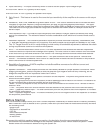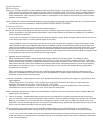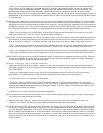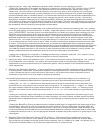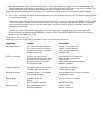3. Adjusting the Hi, 12dB / Low, 24dB Mono @ 40Hz–350Hz Variable X-over Frequency Controls –
• Setting for Subwoofers: First enable the electronic crossover by selecting the “ON” position of the X-OVER
switch, and then select the “L-PASS” (Low pass) position on the L-PASS/H-PASS switch. Next, using “L-
PASS FREQ” you have control over what frequency you want your amp to start crossing over your signal.
By turning this control all the way counter-clockwise you are crossing the signal over at 40Hz (the range is
counter-clockwise 40Hz to clockwise 350Hz). This means that the amp will send the woofers frequencies from
20Hz to 40Hz and then start to taper down as the frequencies get over 40Hz (octave roll off). The industry
standard for low pass crossover point is right around 90Hz. However, by experimenting with the crossover
point (higher or lower) you will fi nd what sounds best in this install. This amp uses a 24 decibel per octave roll
off, which is pretty steep, or tapers off fairly quickly from the crossover point. This design complements both
the subwoofer and the mids to provide greater musical detail.
• Setting for Components and Separates: First enable the electronic crossover by selecting the “ON” position
of the X-OVER switch, and then select the “H-PASS” (High pass) position on the L-PASS/H-PASS switch. Next,
using “H-PASS FREQ” you have control over what frequency you want your amp to start crossing over your
signal. By turning this control all the way counter-clockwise you are crossing the signal over at 40Hz (the
range is counter-clockwise 40Hz to clockwise 350Hz). This means that the amp will send the components or
separates frequencies from 40Hz to 20kHz and then start to taper down as the frequencies get under 40Hz
(octave roll off). The industry standard for high pass setting or X-over point is around 120Hz. When the amp
is in HP setting and the X-over point is set to 120Hz, the amp is sending the speakers frequencies from 120Hz
to 20kHz. This crossover network allows the drivers to recreate the frequencies within a precisely designed
range so that the speakers do not become distorted by trying to reproduce frequencies that they are physically
unable to reproduce. This feature ensures that the components or separates do not receive low bass notes.
The 12dB/oct means the slope, or the amount of other frequencies that will be affected, is fairly narrow. This
design complements both the subwoofer and the mids to provide greater musical detail.
• Setting for Full Range (No Crossover): To disable the electronic crossover, select the “OFF” position of the
X-OVER switch. This setting will allow the amplifi er to play all frequencies.
4. Setting the 30Hz, 12dB Fixed Subsonic Filter – First enable the Subsonic Filter by selecting the “ON” position
of the SUBSONIC FILTER switch. This feature will help remove some of the potentially damaging low
frequencies of 30 Hz and below from your subwoofer system. Use this feature if the subwoofer breaks up at
lower frequencies.
5. Adjusting the Parametric Equalizer – In some applications, the bass amplifi er needs some help in boosting
or cutting certain frequencies. A parametric equalizer is distinguished from a conventional equalizer circuit
in that it allows the user to control the level of the boost or cut as well as the center frequency and the
bandwidth of the boost or cut (the range of frequencies affected).
The following steps describe what each of the three controls of the parametric Bass EQ do in isolation. It is
important to understand these behaviors, because they must all be considered when setting up the EQ.
• Setting the “Q”: The “Q” feature can be adjusted to affect a range of frequencies from as wide as 0.5 to
as narrow as 4.0. As a general rule of thumb, start tuning with a “Q” setting below “2”. Higher “Q” values
are rarely needed unless there is some bizarre acoustic problem in the system. Lower “Q” values give you
a broader (and usually more natural-sounding) effect. A “Q” of “1.6” (10 o’clock setting) is a good starting
point.
• Setting the Frequency: Begin listening for the loudest musical spot or range within the bass range of your
sound system. Adjust the center frequency to match this point. For most systems, the best center frequency
adjustment will be between 40-50Hz. Use 45Hz (12 o’clock setting) as a starting point and adjust up or down
gradually.
• Setting the Boost/Cut: Once you determined the loudest musical spot or range within the bass range of your
sound system, start cutting until the response is smooth and even. You can also boost low spots within the
musical range, but don’t go crazy with the boost knob. There is a lot of boost available, 12dB, but begin with
a low boost setting (around 3dB) and try to stay below 6dB whenever possible. Remember that for every 3dB
of additional boost you dial in, you are asking the amplifi er to double its power output for a given signal in the
boost region.
6. Adjusting The Active Resonance Control (A.R.C.) Feature – This feature will be needed when mounting
speakers lower in the door or in kick panels. Most vehicles have a natural peak that occurs at about 200Hz.
By turning the Pot located on the top control panel clockwise, you CUT 200Hz up to 15dB. This allows you to
remove the unwanted peaks in your mids and highs that occur in most vehicles.




